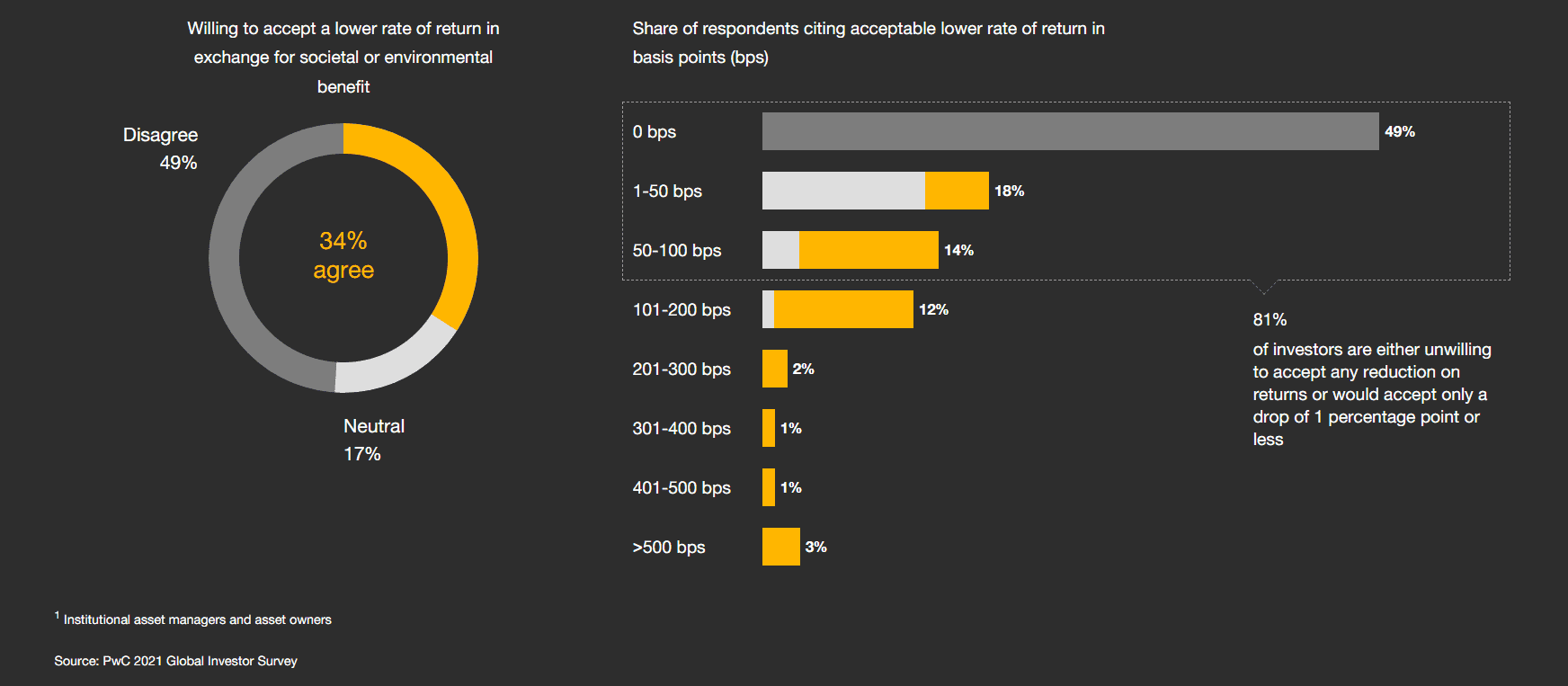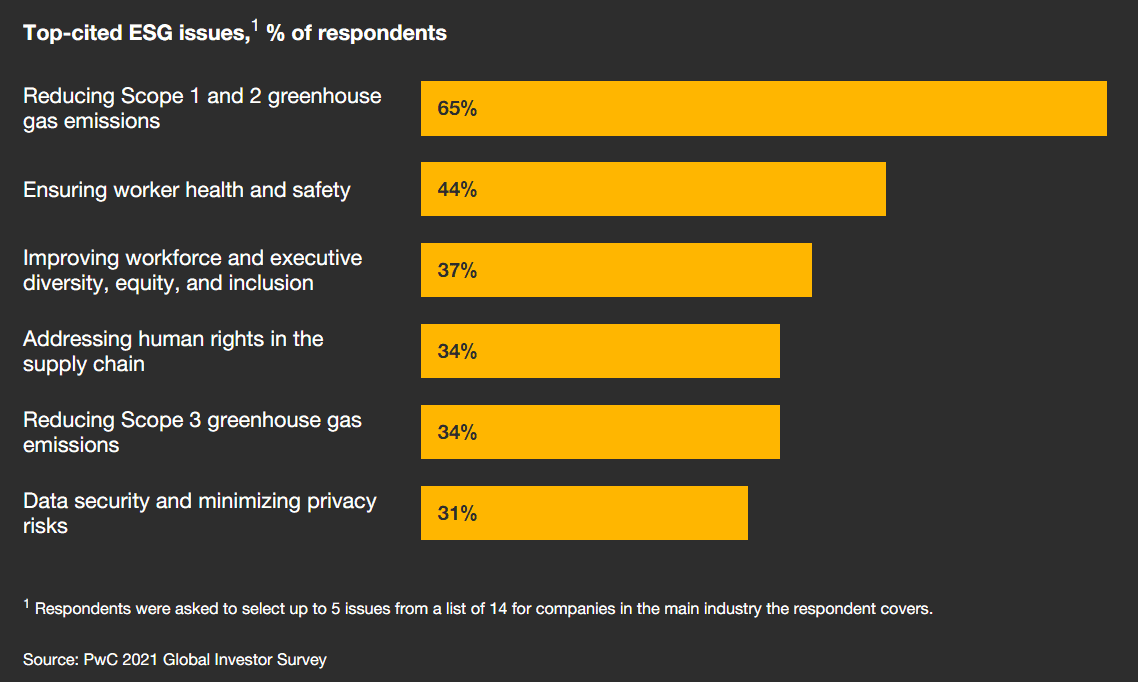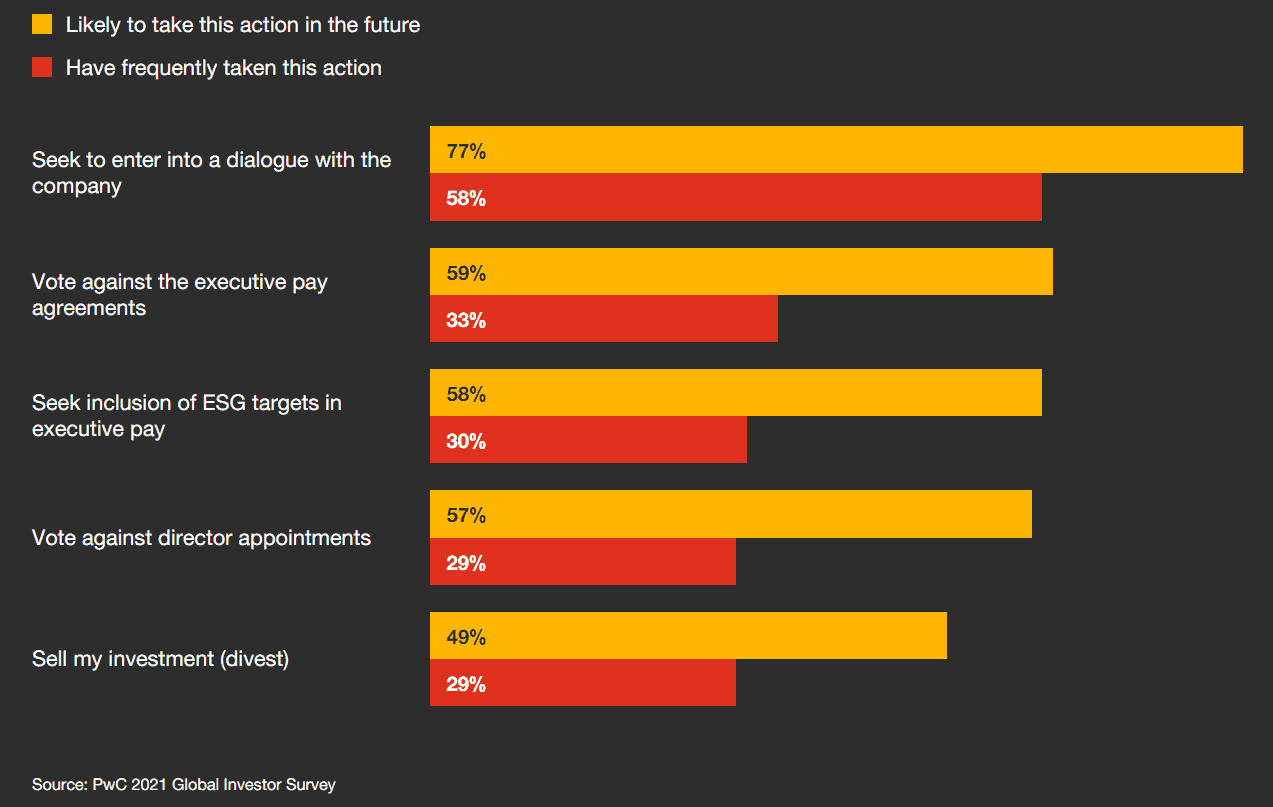Investors prize clarity about the initiatives companies are undertaking, the reporting they are doing—and the returns they will generate. Here’s how leaders can answer the bell.
As we write, on the eve of the COP26 climate change conference, powerful crosscurrents are confronting leaders charting a course for their institutions and the planet. One inescapable reality is that decarbonizing the global economy is a monumental task, with far-reaching economic trade-offs that will challenge countries, industries, companies, and individuals. Another is the growing impact of the environmental, social, and governance (ESG) movement, as it causes major investors, and the companies they hold in their portfolios, to rethink the risks of traditional business models, and the opportunities for more sustainable value creation in the future.
New PwC research, conducted in September 2021, reflects the power of those crosscurrents. We surveyed 325 investors globally, the majority of whom were self-identified active asset managers making investments for the long term. In a wide variety of ways, those investors expressed commitment to ESG goals in their investing and as a priority for their portfolio companies. At the same time, most (81% of) respondents expressed reluctance to take a hit on their returns exceeding 1 percentage point in the pursuit of ESG goals. Many also described significant reservations about the quality of the information available to them when evaluating ESG priorities, including information on the carbon emissions of their investments.
For leaders navigating these crosscurrents, the question is how to deliver both the business transformation necessitated by the changing climate and the returns investors pursue as they discharge their fiduciary duties. Our colleagues have written previously about the tight relationship between reimagined corporate reporting, strategic reinvention, and business transformation to drive ESG and value creation in tandem. Our new research reinforces those priorities, and offers fresh insights about the leadership required to lead such a transformation, the way companies tell their ESG “story,” and the standards and transparency that can help with both.
Rising commitment
A major takeaway from our research is that investors are paying more attention to the ESG risks and opportunities facing the companies they invest in, and are poised to take action. Nearly 80% said ESG was an important factor in their investment decision-making; almost 70% thought ESG factors should figure into executive compensation targets; and about 50% expressed willingness to divest from companies that didn’t take sufficient action on ESG issues. More in-depth interviews conducted as part of our research reinforced these findings. Said one investment firm’s head of ESG, “We’re at a tipping point where ESG has gone mainstream. You can’t walk into a financial institution now to talk about long-term themes without mentioning ESG.”
Investors are catching up on ESG—and they’re ready to act.
Attitudes toward ESG risks and opportunities, % of respondents who agree

These high commitment levels are relatively new, suggests separate PwC research. As recently as 2016, for example, only 39% of asset and wealth management (AWM) CEOs we surveyed as part of PwC’s 19th Annual Global CEO Survey were concerned about the threats posed by climate change. Five years later, almost 70% of AWM CEOs expressed concern about climate in PwC’s 24th Annual Global CEO Survey, released in March 2021.
No free lunch
Our new survey also suggests investors are torn between what they view as a responsibility to the planet and society and their fiduciary responsibilities to their clients. Most (75%) of the investors we surveyed said they thought it was worth companies sacrificing short-term profitability to address ESG issues. On the other hand, as noted above, a similar percentage (81%) said they would be willing to accept, in pursuing those goals, only 1 percentage point or less of a haircut on their investment returns. Nearly two-thirds of that group was unwilling to accept any reduction in return.
Many investors are hesitant to accept a lower rate of return in exchange for ESG benefits.
A breakdown of what investors will accept, % of respondents1

None of this is surprising. Investors operate in competitive markets, where capital chases returns and underperformers are weeded out. In addition, “asset managers have a fiduciary duty—and can’t prioritize social [issues] over return on investment,” noted one credit ratings analyst. There are also time-horizon issues at play: investors must balance short-term results with longer-term, more existential—but also more uncertain—risks to the value-creation prospects of their portfolio companies. As PwC global chairman Bob Moritz wrote late last year, the global capital markets, as they currently operate, cannot be expected to single-handedly solve society’s biggest problems. Governments, business, the capital markets, and society all play a vital role—and so does high-quality information, including information about nonfinancial matters.
The information imperative
Investors’ focus on companies’ ESG-related commitments and actions in recent years has brought reporting into the spotlight. Investors are using companies’ sustainability reports and setting up investing screens based on benchmarks that track everything from emissions levels to human rights to diversity in the boardroom.
As useful as these benchmarks are, our survey highlighted a number of deficiencies in current ESG reporting; only about one-third of investors, on average, think the quality of the reporting they’re seeing is good enough. Simply put, investors cannot easily differentiate between companies on ESG-related performance. Investors question whether much of today’s ESG reporting gives them the relevant, reliable, timely, complete, and comparable information they need for effective decision-making. “That is why trust is so critical,” according to one head of engagement at an investment firm. “More is required for investors before they pull the trigger and invest money.” Better reporting would help investors more readily understand how a sustainable business model leads to long-term viability, assess how ESG strategy translates into value creation, and determine whether a company’s actions have the potential to lead to negative impacts on the planet or people.
Emissions crosscurrents
The complexity of ESG reporting challenges comes into sharp focus on climate issues. Just over a third of investors in our survey think the quality of the information they get on environmental issues is good enough. Those information challenges can be problematic for investors, many of whom are thirsty for information about carbon emissions. When we asked investors which ESG issues they think companies should prioritize, the most cited, by a wide margin, was reducing Scope 1 emissions (direct emissions from a company’s operations) and Scope 2 emissions (indirect emissions from purchased or acquired electricity, steam, heat, and cooling).
Reducing Scope 1 and Scope 2 greenhouse gas emissions is the most cited ESG issue for companies to prioritize.
Top-cited ESG issues,1 % of respondents

Particularly difficult, today, is the tracking and reporting of Scope 3 emissions (those resulting from activities not in a company’s direct control, such as the use of its products and services). It’s probably no coincidence that such emissions were lower on investors’ ESG priority list. In fact, according to one investment firm’s head of ESG we interviewed, “Many asset managers don’t have the capability to fully assess the data they see for Scope 3 emissions” (which represent 65–95% of most companies’ broader carbon impact, according to the Carbon Trust, a group that helps companies measure carbon emissions). Still, as regulations come into place, for investors such as investment firms, pension funds, and insurance companies to monitor and report on the carbon footprint of their portfolios, the importance of reporting on all types of emissions should only grow.
Trade-offs and progress
Although the tensions we’ve been describing are challenging both for investors and for the companies they invest in, they’re not an insurmountable barrier to progress. Here’s how three companies have been navigating the trade-offs:
- California utility PG&E experienced financial distress after its operations contributed to wildfires, then embarked, in July 2021, on a US$20 billion effort to bury 10,000 miles of power lines to help cut the risk of future wildfires. “We know that we have long argued that undergrounding was too expensive,” Patti Poppe, CEO of PG&E, said in a statement at the time. “This is where we say it’s too expensive not to underground.”
- Investors rewarded BP last August when the company outlined a detailed plan to invest around US$5 billion a year in renewable energy like wind, solar, and hydrogen—about ten times its current amount—even while BP reported a US$16.8 billion quarterly loss and cut its dividend in half. On the day that BP announced the disappointing earnings and ambitious climate plan, the company’s share price jumped by more than 7%. “There are significant risks for BP” and other large oil companies as they move toward lower-carbon businesses, said Jennifer C. Rowland, an analyst at Edward Jones, commenting on the earnings announcement. “However, the risk of inaction is just as significant, as the value of their traditional oil and gas assets, as well as their relevance in the energy world, could be diminished over time.”
- In a recent interview with PwC’s strategy+business, Dale Vince, the CEO of UK energy company Ecotricity, said the company is working to shutter, rather than sell, its fossil fuel assets. “If you’re a generator and you’ve got big power stations, you don’t want to turn them off,” Vince said. “You want to get the maximum return and see them come to the end of their life. You might even want to extend their lifetime. But we’ve got to give things up. We’re going to have to take a loss in some areas, because we’re going to need to start the new things sooner rather than later.”
Examples like these suggest the potential for progress—and often a recognition that it may be necessary to suffer short-term reductions to cash flows and profits in exchange for creating more viable, long-term operating models.
Three priorities for the road ahead
For companies stretching to find their way amid similar trade-offs, our survey points to a few actions leaders can take immediately that will advance their ESG agendas and bring their investors and other stakeholders with them along on the journey.
1. Harness the power of the C-suite. In our survey, 82% said companies should embed ESG directly into their corporate strategy. Investors also emphasized the importance of leadership from the top team, starting with the CEO. The chief executive is particularly well-positioned to communicate the importance of ESG to all stakeholders—including customers, employees, and shareholders—while making difficult resource-allocation trade-offs associated with ESG initiatives. Other members of the C-suite have a critical role to play, too. Observed one credit ratings analyst we interviewed, it’s when C-suite leaders are “actively engaged” with ESG that “we have seen it cascade through the business.” Intuitive as all this may seem, it’s not always consistent with reality. For example, according to PwC’s most recent Global CEO Survey, just 40% of CEOs have factored climate change into their strategic risk management, without which it is more difficult to drive a corporate sustainability agenda.
2. Think holistically about your ESG story. According to our survey, investors use annual reports, sustainability reports, and investor presentations by far the most frequently to understand how a company is addressing ESG issues. These sources, and the ESG story they convey, are well within your control. The breadth of issues covered in ESG reporting points to the need for a wide range of expertise to pull it all together in a cohesive way. Sustainability teams, risk teams, financial reporting teams, and investor relations teams should work together—giving further evidence that a company takes its ESG reporting as seriously as it does its financial reporting, and recognizes the market-moving information that ESG reporting increasingly provides.
A holistic approach to reporting should not be an end in itself; your reporting will inform a proactive dialogue with your investors, helping to assure them that your company is on the right track when it comes to advancing ESG strategy. If they can’t see that you are making progress, our survey indicates that they’ll consider actions ranging from engagement on executive compensation to voting against directors and resolutions to—in more extreme cases—divesting altogether.
Investors are increasingly willing to take action if companies are not adequately addressing ESG issues.
Response to a company’s insufficient action on addressing ESG issues, % of respondents

3. Drive toward common standards, greater transparency, and more reliability. Although nearly three-quarters of respondents to our survey say a single set of ESG reporting standards would help their decision-making, there are no unified global standards for reporting ESG information. In the breach, companies should leverage the best of existing standards, focusing, at least initially, on the topic of climate—in response to urgent demand. By disclosing methodologies alongside results, companies can contribute to a communal knowledge of best practices as reporting standards and measurement practices evolve.
More specifically, investors told us that, wherever possible, companies should start with the standards and frameworks issued by recognized bodies (such as the Task Force on Climate-related Financial Disclosures), which have a clear due process and wide consultation. And when applying a standard, do so in its entirety—investors are wary of selective reporting, or “cherry-picking” only the most favorable information. As one analyst told us, “With regard to ESG issues, companies should disclose not only the good news (something they’ve achieved), but also the bad news—where they’ve had challenges.”
As part of this work, leaders should take care not to inundate investors with reams of data just for the sake of more disclosure, or to overreach and fall prey to “greenwashing” critiques. The top characteristic that investors are looking for in ESG reporting is the relevance of the ESG issue to the company’s business model. Keep asking yourself: is this disclosure of high quality? And will it serve to help investors develop a clearer picture of the company’s ESG journey—both its destination and its progress toward meeting ESG targets along the way?
Bringing investors along
The investors in our survey sent a clear message: if companies take the right actions on ESG, investors will support it, but they want to be brought along for the ride, however bumpy it might be. That means being upfront about your prospects for long-term value creation and the ways in which you’ll manage risks, including unexpected ones. When you tell investors and other stakeholders how you plan to reset your strategy, reimagine your reporting, reinvent your operations, and drive toward new outcomes, you build trust while creating sustainable value for the long term.

 5.0
5.0 





















